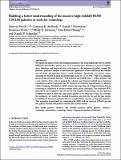Por favor, use este identificador para citar o enlazar a este item:
http://hdl.handle.net/10261/150275COMPARTIR / EXPORTAR:
 SHARE SHARE
 CORE
BASE CORE
BASE
|
|
| Visualizar otros formatos: MARC | Dublin Core | RDF | ORE | MODS | METS | DIDL | DATACITE | |

| Título: | Building a better understanding of the massive high-redshift BOSS CMASS galaxies as tools for cosmology |
Autor: | Favole, Ginevra; McBride, C. K.; Eisenstein, Daniel J.; Prada, Francisco CSIC ORCID ; Swanson, M. E.; Chuang, C. H.; Schneider, D. P. | Palabras clave: | Galaxies: statistics Cosmology: observations Cosmology: theory Galaxies: distances and redshifts Galaxies: haloes Large-scale structure of the universe |
Fecha de publicación: | 2016 | Editor: | Oxford University Press | Citación: | Monthly Notices of the Royal Astronomical Society 462: 2218- 2236 (2016) | Resumen: | We explore the massive bluer star-forming population of the Sloan Digital Sky Survey (SDSS) III/BOSS CMASS DR11 galaxies at z > 0.55 to quantify their differences, in terms of redshiftspace distortions and large-scale bias, with respect to the luminous red galaxy sample. We perform a qualitative analysis to understand the significance of these differences and whether we can model and reproduce them in mock catalogues. Specifically, we measure galaxy clustering in CMASS on small and intermediate scales (0.1 ≲ r ≲ 50 h Mpc) by computing the two-point correlation function - both projected and redshift-space - of these galaxies, and a new statistic, Σ(π), able to separate the coherent and dispersed redshift-space distortion contributions and the large-scale bias. We interpret our clustering measurements by adopting a Halo Occupation Distribution (HOD) scheme that maps them on to high-resolution N-body cosmological simulations to produce suitable mock galaxy catalogues. The traditional HOD prescription can be applied to the red and the blue samples, independently, but this approach is unphysical since it allows the same mock galaxies to be either red or blue. To overcome this ambiguity, we modify the standard formulation and infer the red and the blue models by splitting the full mock catalogue into two complementary and non-overlapping submocks. This separation is performed by constraining the HOD with the observed CMASS red and blue galaxy fractions and produces reliable and accurate models. © 2016 The Authors. | URI: | http://hdl.handle.net/10261/150275 | DOI: | 10.1093/mnras/stw1801 | Identificadores: | doi: 10.1093/mnras/stw1801 issn: 1365-2966 |
| Aparece en las colecciones: | (IAA) Artículos (IFTOX) Artículos |
Ficheros en este ítem:
| Fichero | Descripción | Tamaño | Formato | |
|---|---|---|---|---|
| IAA_2016_MNRASstw1801.pdf | 2,34 MB | Adobe PDF |  Visualizar/Abrir |
CORE Recommender
SCOPUSTM
Citations
13
checked on 20-abr-2024
WEB OF SCIENCETM
Citations
11
checked on 23-feb-2024
Page view(s)
413
checked on 24-abr-2024
Download(s)
253
checked on 24-abr-2024
Google ScholarTM
Check
Altmetric
Altmetric
NOTA: Los ítems de Digital.CSIC están protegidos por copyright, con todos los derechos reservados, a menos que se indique lo contrario.
